
A "Land Bridging Loan" is fast, short-term finance secured against land typically used for purchasing or refinancing land.
Land Bridging Loans (Land Loans) are suitable for financing all types of land, including land with or without planning, with or without structures, Agricultural, Development, Greenbelt, Greenfield, Brownfield or Greyfield land.
When you're looking for a loan to buy land or refinance it, we'll help you get the best rate bridging loan on the right terms. We're experts at financing land, whether a large residential or semi-commercial development site, garden plot, ransom strip, or buying agricultural land, woodland, or a car park.
Our land bridging loans are available to experienced developers, investors, speculators, business owners, and individuals. They range from £50k-£250m and have terms of 1-36 months.
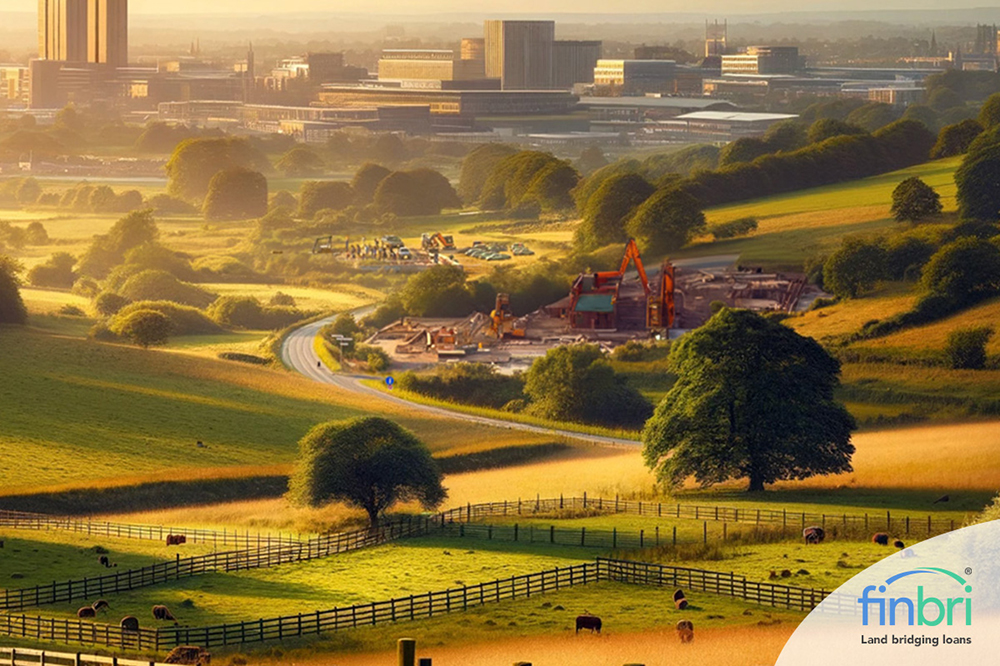
Our Land Bridging Loan service
- Market-leading land bridging loans from £50,000 to £250,000,000
- Land finance and land refinance
- Monthly interest rates from 0.75% pm
(Lower rates for £700,000+ loans or less than 50% LTV) - LTVs up to 70% (100% land finance when additional collateral available)
- No monthly payment option with rolled-up interest
- Terms up to 36 months
We provide a reliable service, quickly securing the maximum finance to buy or refinance your land at the best available rates.
Our short-term finance is available on all types of land in England, Scotland, Wales and Northern Ireland, and we're able to raise:
up to £300k loans in 3 days
up to £750k loans in 7 days
up to £250m from 14 days
We consider all types of credit history, including non-status and bad/adverse and don't perform automated credit checks, so there's no footprint from enquiring.
With access to the largest network of UK lenders, including specialist land bridging loan lenders, family offices, private equity firms and private investors, we can source the best rate land loan you require.
We arrange finance for property developers, investors and business owners for land purchases, land banking, and land development at any scheme size. Whether you need fast financing to take advantage of a time-critical opportunity, have to refinance to allow time for a change of use, gain more favourable planning consent, or begin development, we can arrange financing for even the most complex circumstances.
No deal is too challenging, and every case is fully considered on merit. We're experts in packaging your needs so that our lenders can understand their value and lend against them.
Where your timeline is critical and short, we're confident we can get your land finance in place. Get your best no-obligation quote with us today.
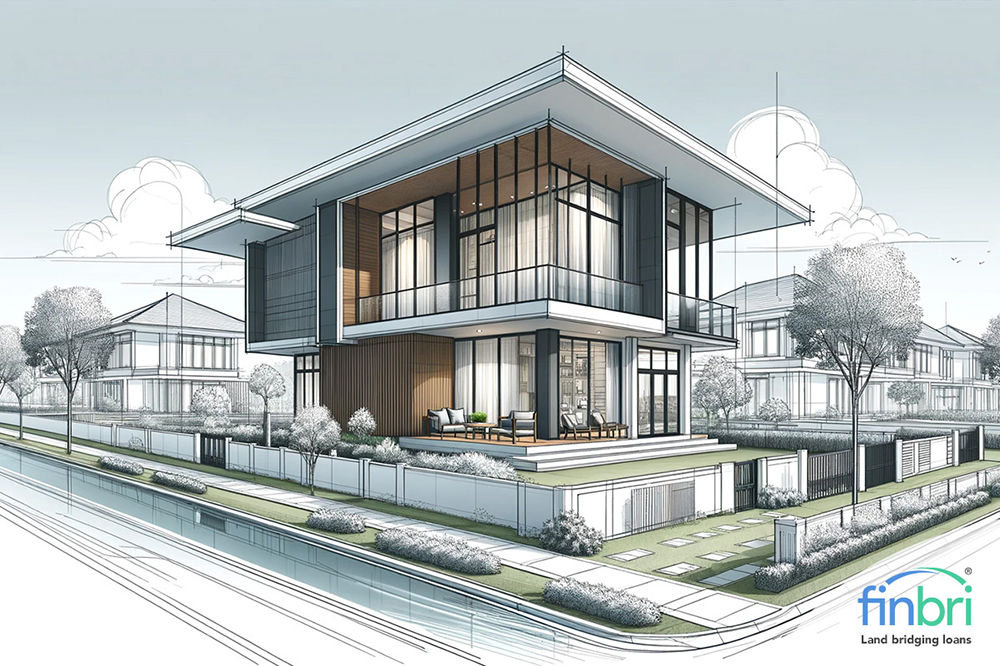
Land Bridging Loan Criteria
| Loan to value (LTV) | Land with planning up to 70% Land without planning up to 50% 100% Funding available with additional security |
| Loan term | 1 to 36 months |
| Loan amount | £50,000 up to £250m |
| Interest options | Rolled-up, retained or serviced |
| Interest rates | From 0.75% |
| Decision | Immediate decision in principle |
| Completion | Up to £300k loans in 3 days Up to £750k loans in 7 days Up to £250m from 14 days |
| Early repayment fees | None |
| Availability | Secured on assets in UK & Europe Individuals, Companies, SPVs, Partnerships, LLPs & Ltd No credit & adverse credit considered |
| Exit strategy | Sale or refinance |
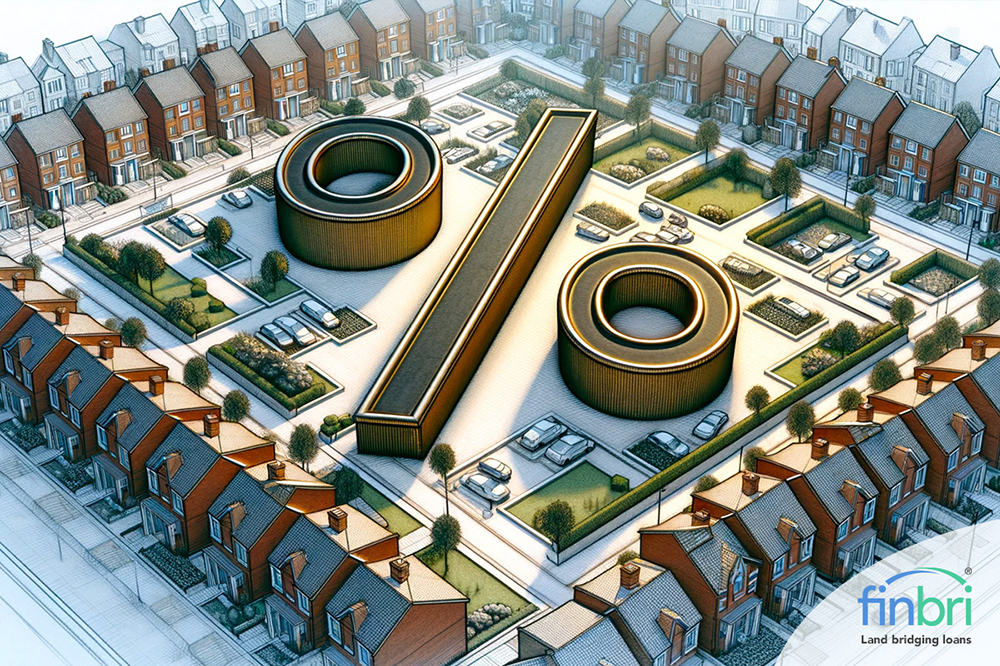
What are the costs of a Land Bridging Loan?
The five key costs of a land bridging loan are Interest, lender Arrangement Fee, Broker Fee, Valuation Fee, and Legal Fees.
How much interest will I pay For a land bridging loan?
Land with planning permission attracts an interest rate of 0.75% per month.*
Land with no planning attracts an interest rate between 1.25%-2% per month.*
*Interest rates available will vary based on lender, land location and exit strategy.
| Land Bridging Loan Value in £ GBP |
With Planning at 0.75% per month |
Without Planning Permission at 2.00% per month |
|---|---|---|
| £100,000 | £750 | £2,000 |
| £250,000 | £1,875 | £5,000 |
| £500,000 | £3,750 | £10,000 |
| £750,000 | £5,625 | £15,000 |
| £1,000,000 | £7,500 | £20,000 |
| £2,500,000 | £18,750 | £50,000 |
| £5,000,000 | £37,500 | £100,000 |
| £10,000,000 | £75,000 | £200,000 |
How much will the lender's arrangement fee cost for a land bridging loan?
Lender arrangement fees are typically 2% for loans below £1m of loan amount.
Larger loans attract a lower rate of 1.5%.
Land Bridging Loan arrangement fee examples
| Land Bridging Loan Value in £ GBP |
2.0% Arrangement Fee in £ GBP |
1.5% Arrangement Fee in £ GBP |
|---|---|---|
| £100,000 | £2,000 | £1,500 |
| £200,000 | £4,000 | £3,500 |
| £300,000 | £6,000 | £4,500 |
| £400,000 | £8,000 | £6,000 |
| £500,000 | £10,000 | £7,500 |
| £600,000 | £12,000 | £9,000 |
| £700,000 | £14,000 | £10,500 |
| £800,000 | £16,000 | £12,000 |
| £900,000 | £18,000 | £13,500 |
| £1,000,000 | £20,000 | £15,000 |
| £2,000,000 | £40,000 | £35,000 |
| £3,000,000 | £60,000 | £45,000 |
| £4,000,000 | £80,000 | £60,000 |
| £5,000,000 | £100,000 | £75,000 |
| £10,000,000 | £200,000 | £150,000 |
How much is the broker fee for Bridging Loans for Land?
Broker fees for land bridging loans are usually 1-2% of the gross loan amount.
Land Bridging Loan Broker Fee examples
| Land Bridging Loan Value in £ GBP |
1.0% Broker Fee in £ GBP |
2.0% Broker Fee in £ GBP |
|---|---|---|
| £100,000 | £1,000 | £2,000 |
| £200,000 | £2,000 | £4,000 |
| £300,000 | £3,000 | £6,000 |
| £400,000 | £4,000 | £8,000 |
| £500,000 | £5,000 | £10,000 |
| £600,000 | £6,000 | £12,000 |
| £700,000 | £7,000 | £14,500 |
| £800,000 | £8,000 | £16,000 |
| £900,000 | £9,000 | £18,500 |
| £1,000,000 | £10,000 | £20,000 |
| £2,000,000 | £20,000 | £40,000 |
| £3,000,000 | £30,000 | £60,000 |
| £4,000,000 | £40,000 | £80,000 |
| £5,000,000 | £50,000 | £100,000 |
| £10,000,000 | £100,000 | £200,000 |
How much will the Survey/Valuation Fee cost for valuing the Land?
Valuation fees typically cost £100 per £100,000 of land value but will vary depending on the type of land being valued.
How much will the Legal Fees cost to complete a Bridging Loan?
Legal fees for a bridging loan can range from several hundred to several thousand pounds, depending on the situation's complexity. You'll be advised of anticipated legal fees at the time of application, and you'll be responsible for paying your legal costs and those of your lender.
Our 2024 guide to Land Bridging Loans
Land bridging finance is helpful for individuals, developers, and businesses eyeing rapid land acquisition or refinancing. This guide explores the nuances of securing a Land Bridging Loan, a financial tool designed to purchase or refinish land quickly.
Whether it's land with or without planning permission, agricultural fields, or development sites, the versatility of this finance caters to a broad spectrum of needs. From understanding the application process and eligibility criteria to exploring the advantages and potential drawbacks, this guide equips you with the essential knowledge to leverage land bridging finance effectively.
Contents
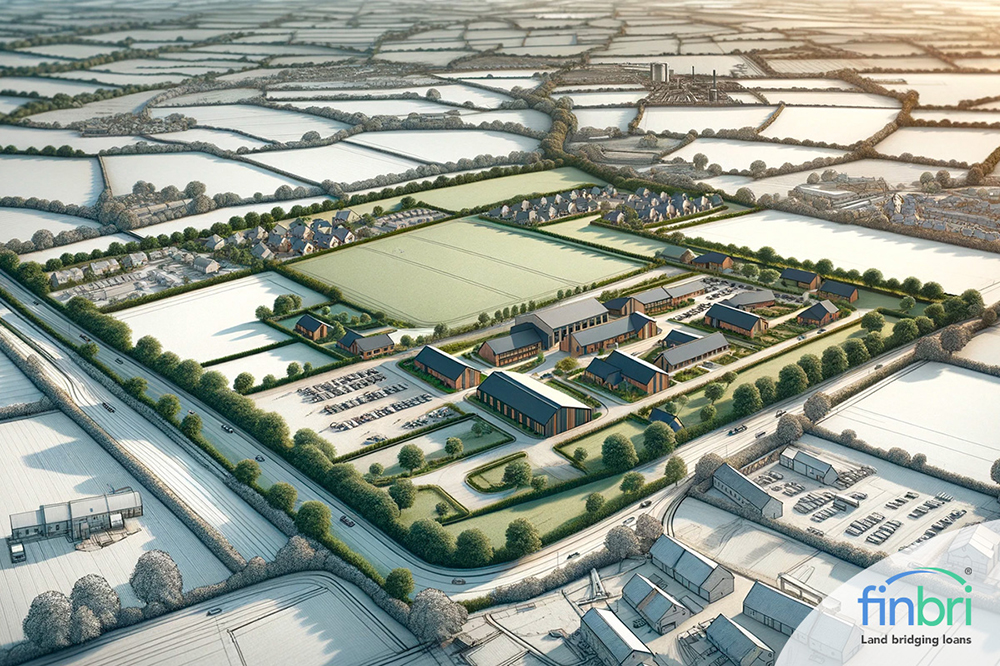
What is a Land Bridging Loan?
A "Land Bridging Loan" is short-term finance secured against land designed to purchase or refinance land. Land that can be financed includes land with or without planning, with or without structures, Agricultural, Brownfield, Greenbelt, Greenfield and Greyfield land.
Land finance is often used to bridge the gap between the purchase of land and its development. As such, it's most commonly used by property developers, investors, and speculators for land purchases, land banking, or development sites.
It's also used by businesses and individuals who wish to purchase plots of land such as agricultural (arable and pasture) fields, meadows, and woodlands for various purposes.
Due to the high demand for land in the UK, purchasing quickly can often make or break a land deal. This fast specialist financial product can be arranged in as little as 72 hours, enabling you to seize land opportunities when they arise. This guide gives you the knowledge to do just that.

How can Land Bridging Finance be used?
Land Bridging Loans can be used to buy and refinance land.
Purchasing Land: Land bridging finance allows borrowers to secure a land purchase quickly.
Refinancing Land: Planning delays and the need to refinance before your loan term ends are not uncommon. Land can be refinanced to extend the loan term and allow owners to realise the land's full value.
How can I purchase land using a loan?
Purchasing land with a loan involves several steps, from determining your needs and budget to securing financing and closing the deal. Here's a simplified guide to help you navigate the process:
Step 1. Assess Your Needs and Budget
- Identify the Purpose: Determine why you want to purchase the land. This could be for residential construction, agriculture, investment, or commercial development. Each comes with different interest rates, fees, and maximum loan-to-values, so explain to your broker or lender which type of land you wish to purchase.
- Budgeting: Assess how much you can afford to spend on the land purchase, including deposit (cash into the purchase), monthly loan payments if you intend to service the loan monthly, Stamp Duty Land Tax, and potential development costs if you intend to develop the land.
Step 2. Find the Right Land
Research: Look for land that meets your requirements regarding location, size, planning, and accessibility. Consider factors such as proximity to utilities, roads, and the site's topography.
Due Diligence: Conduct thorough due diligence once you've identified a potential piece of land. This includes checking for clear title, understanding zoning laws, and ensuring no liens or encumbrances on the property.
Step 3. Explore Financing Options
Not all lenders offer loans for land purchases, so you'll likely need to go through a broker to find one that does. Land loan options include Bridging loans for land, Planning gain finance, Agricultural mortgages, and Property development finance.
- Bridging Loans for Land: These are short-term loans that allow you to quickly purchase land of any type before refinancing the loan with longer-term finance such as a mortgage, development finance or full repayment. Maximum loan-to-values are 70%, meaning you'll need to put 30% into the purchase as cash (deposit). Another way to look at it is to put in £30,000 for every £100,000 of the land purchase price. The typical bridging loan interest rate is 0.75% per month.
- Planning Gain Finance: This is short-term finance designed explicitly for land that will gain monetary value from planning, either through land without planning becoming land with planning or where the existing planning has been enhanced. Maximum loan-to-values are 80%, meaning you'll need to put 20% into the purchase as cash (deposit). Another way to look at it is to put in £20,000 for every £100,000 of the land purchase price. The typical bridging loan interest rate is 0.75% per month.
- Agricultural Land Finance (Agricultural Mortgages): Agricultural land finance (agricultural mortgages) is long-term, typically lasting up to 30 years. The agricultural land used as collateral can be raw land (arable fields, pasture, woodland, etc) or land with agricultural buildings, such as a farmhouse, outbuildings or barns.
- Property Development Finance: This type of financing is commonly used to acquire a site with or without existing buildings on it and for the ground-up construction of buildings. Development finance is the most appropriate form of financing for land with planned improvements or immediate development.
Step 4. Apply for the Loan
Source Finance Brokers or Lenders: You can source a land loan directly from a broker or a lender. Speaking with a broker will allow you to ensure your loan application is presented to several lenders in the best possible light, encouraging competition in the market for your specific land loan. This ensures you get the most competitive quotes from the market and gives you an accurate idea of how much you can borrow before committing to any one lender.
Application Process: You'll need to provide financial documents, details about the land, the entity purchasing the land (whether an individual or company), and a purpose for the loan, such as the plan for its use and how you intend to repay it. If it's for development, then a schedule of work, development costs, details of the main contractor and trades, and details of your experience as a developer will be required. The lender will assess your creditworthiness, the land's value, and your plans for the property.
Step 5. Closing the Deal
Offer and Negotiation: Make an offer on the land based on its appraised value and any findings during the due diligence. You will be required to complete a valuation survey, and the lender will use the valuation report to determine the current market value of the land. Be prepared to negotiate with the seller if this valuation is lower than anticipated [or you'll need to find the difference either with cash or as additional collateral.
Closing: Once the loan is approved and terms are agreed upon with the seller, you'll close the deal. This involves signing documents, paying legal fees, broker and lender arrangement costs, and receiving the deed to the land.
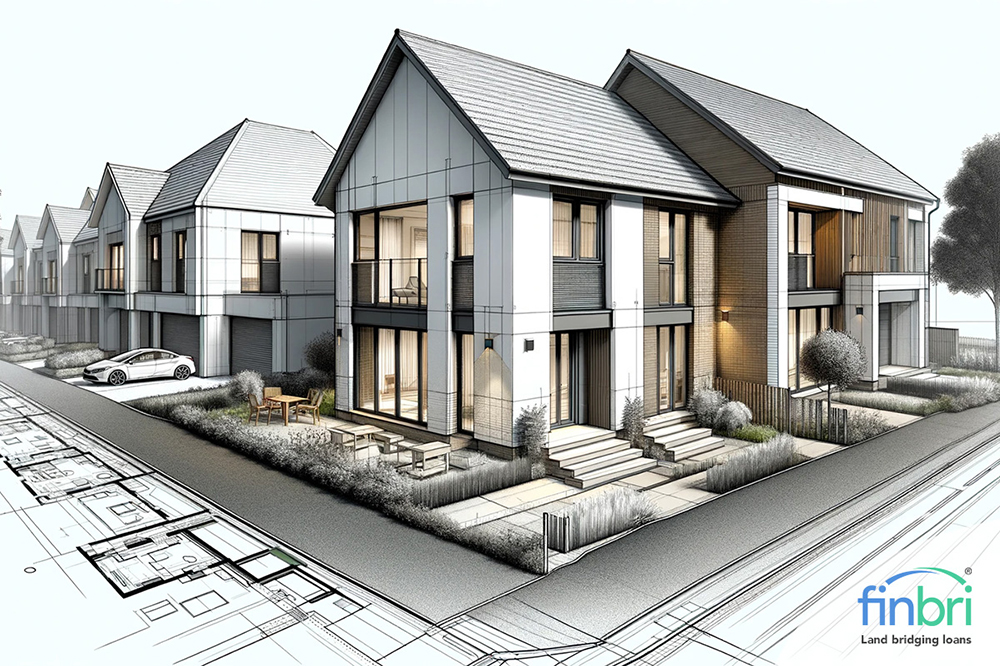
What kind of land can be financed?
The three most common uses of land bridging loans are:
Property development: It can finance property development projects, such as constructing residential or commercial buildings on the purchased land.
Planning gain finance: Planning gain finance involves purchasing land without planning or restricted and limited planning to increase its value by obtaining more favourable planning consent.
Land at auction: Land bridging finance can help buyers finance property bought at auction and completed within 28 days.

Key features of Bridging Loans for Land:
The five key features of Land Bridging Loans
The five key features of Land Bridging Loans are that they're short-term, fast to arrange, secured on land, have higher interest rates when compared to other forms of finance, and have flexible repayment options.
Short-term financing: Land bridging finance is typically a short-term loan, usually ranging from a few months up to two years, although specific terms vary depending on the lender and your requirements.
Fast approval and funding: Bridging loans for land are known for their quick approval and funding process, allowing borrowers to access funds promptly.
Secured loans: Land bridging finance is typically secured against the land or property being purchased, providing collateral for the loan. However, other assets can be used. For example, the loan could be a residential bridging loan secured on a residential property or a commercial bridging loan secured against a commercial property.
Higher interest rates: Due to the short-term nature and risk involved, bridging loans for land often have higher interest rates than traditional long-term mortgages.
Flexible repayment options: Borrowers can choose from various repayment options, such as monthly interest payments or rolling up the interest to be repaid at the end of the loan term.

Am I eligible for Land Bridging Finance?
Four factors influence lending eligibility for land bridging finance.
Loan purpose: Lenders assess the purpose of the loan, such as land purchase or property development, to determine the project's viability.
Exit strategy: Borrowers must provide a clear and feasible plan to repay the loan, typically through selling the land or property or refinancing with long-term financing.
Property valuation: Lenders evaluate the value of the land or property purchased to determine the loan amount and loan-to-value ratio (LTV). Unfortunately, automated valuations are not possible with land bridging loans.
Borrower's creditworthiness: While credit history is considered, lenders focus more on the security value (the land or property) when assessing eligibility for land-bridging finance.
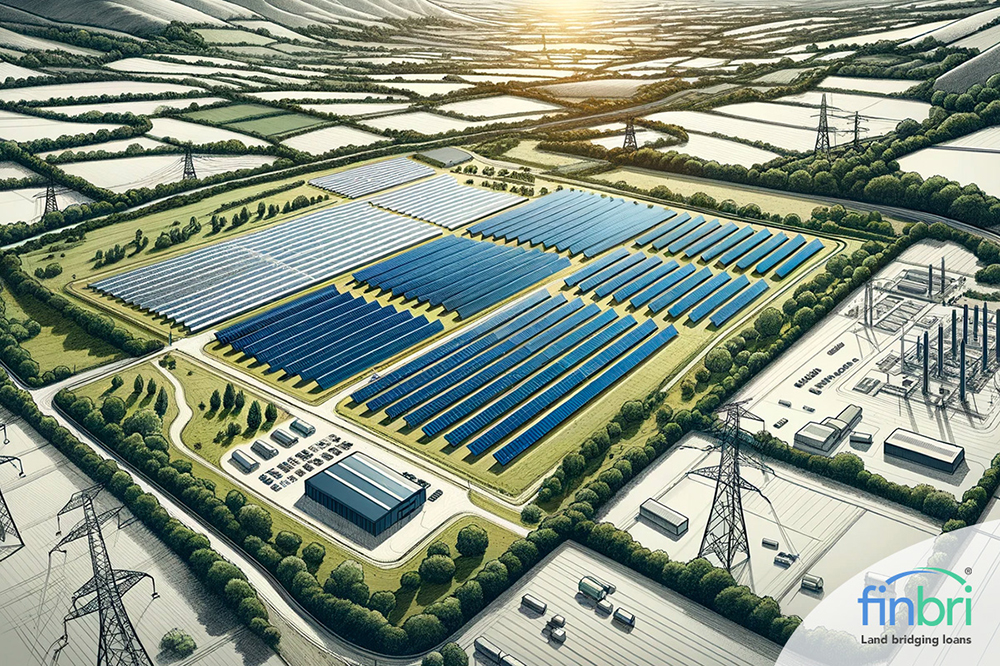
What are the advantages of Land Bridging Finance?
The five Key Benefits of Land Bridging Finance
The five key benefits of Land Bridging Loans are quick access to finance, flexible options, no monthly repayments and higher LTVs than alternative options.
Quick access to funds: Land bridging finance offers a fast bridging solution, enabling borrowers to take advantage of time-sensitive opportunities.
Flexibility: Bridging loans give borrowers flexibility in terms of repayment options, allowing them to choose what suits their financial situation.
No monthly repayments: Some bridging loans offer the option of rolling up interest payments until the end of the loan term, easing short-term financial burdens.
Competitive loan-to-value ratios: Depending on the lender and the specific circumstances, borrowers can achieve higher loan-to-value ratios than alternative financing options.
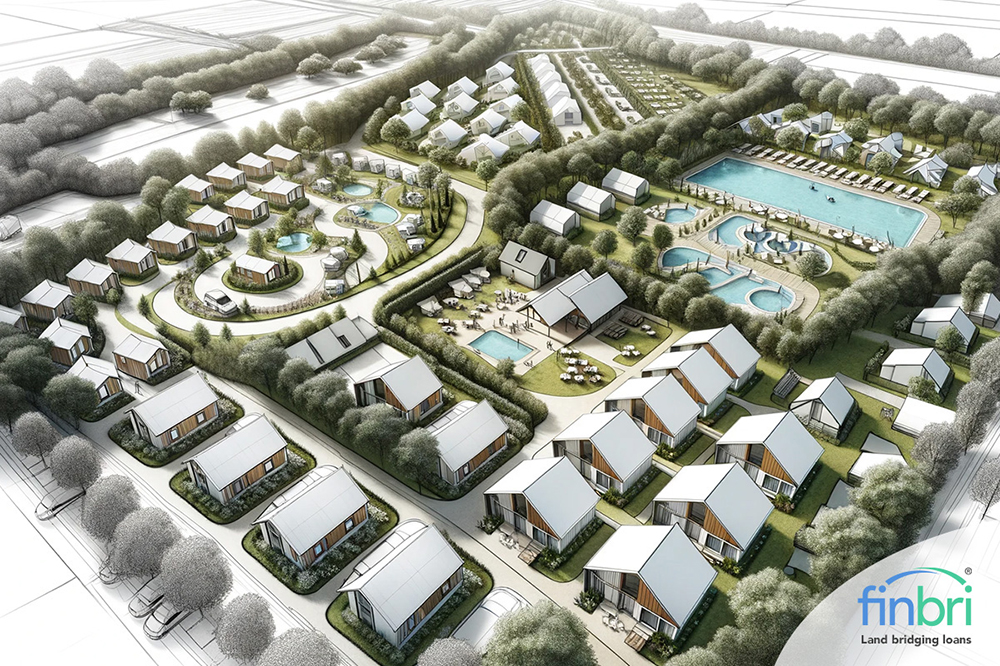
What are the disadvantages of Land Bridging Finance?
The three biggest drawbacks of Land Bridging Finance
The three most significant disadvantages of Land Bridging Loans are Higher interest rates, additional costs, and the risk associated with the exit strategy.
Higher interest rates: Bridging loans typically have higher interest rates than long-term mortgage loans due to the short-term nature and perceived higher risk. Even though the costs of land bridging finance might be considered higher than some forms of financing, there are ways you can improve your rate.
Additional costs: Borrowers should consider additional costs associated with land bridging finance, such as arrangement fees, valuation fees, legal fees, and potentially early repayment charges.
Exit strategy risk: Failure to secure a suitable exit strategy, such as the land sale or refinancing, can result in additional challenges or difficulties in repaying the loan.
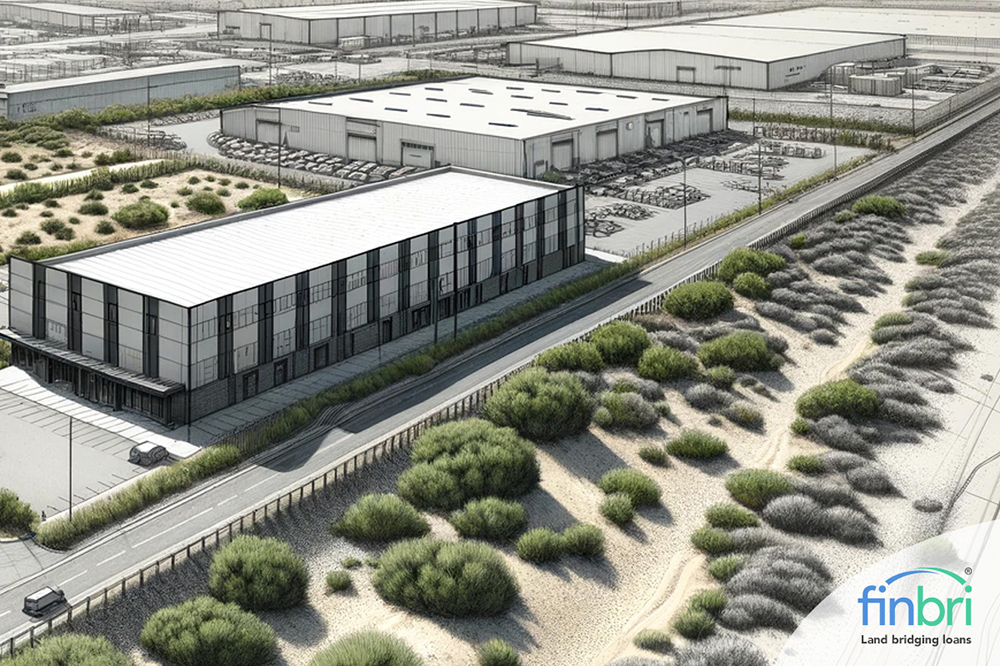
Does the land need planning permission to obtain finance?
No, land does not have to have planning consent for you to finance it.
You can also secure the finance for land against an asset other than the land itself. For example, you could use another property you own as collateral. This provides you with the additional benefit of raising the purchase price of the entire land.
Land with planning permission in place, however, makes it easier to obtain a higher-value loan because land with planning has a higher value.
Land without planning permission can be eligible for land bridging finance, although its value and LTV will be reduced.

Loan-to-Value (LTV) for Land Bridging Finance
The loan-to-value ratio represents the loan amount as a percentage of the purchased land or property.
LTV ratios for land bridging finance typically range from 50% to 75%, depending on the type of land, its purpose, the land's location, and the lender's criteria. However, it's important to note that each lender will have its own specific LTV requirements, so if you're looking to maximise your loan amount, having access to the widest lending panel is in your favour.
Land LTVs and how much you can borrow
Land with planning: Up to 70% - A maximum of £70,000 per £100,000 of land value.
Land without planning: Up to 50% - A maximum of £50,000 per £100,000 of land value.
Land Loan Calculator
How much will your land bridging finance cost?
Use our free land loan calculator to find out the cost of your land bridging loan.
Find your Land loan-to-value with our free LTV calculator.
We're ready to chat through your Land finance requirements.
Call us on 01202 612934 today

Loan duration for Land Bridging Finance
The duration of a land bridging loan is typically short-term, ranging from a few months to two years. However, specific loan durations can vary depending on the lender, the borrower's needs, and the planned exit strategy.
It is important to understand the loan duration and ensure it aligns with your requirements and financial goals.
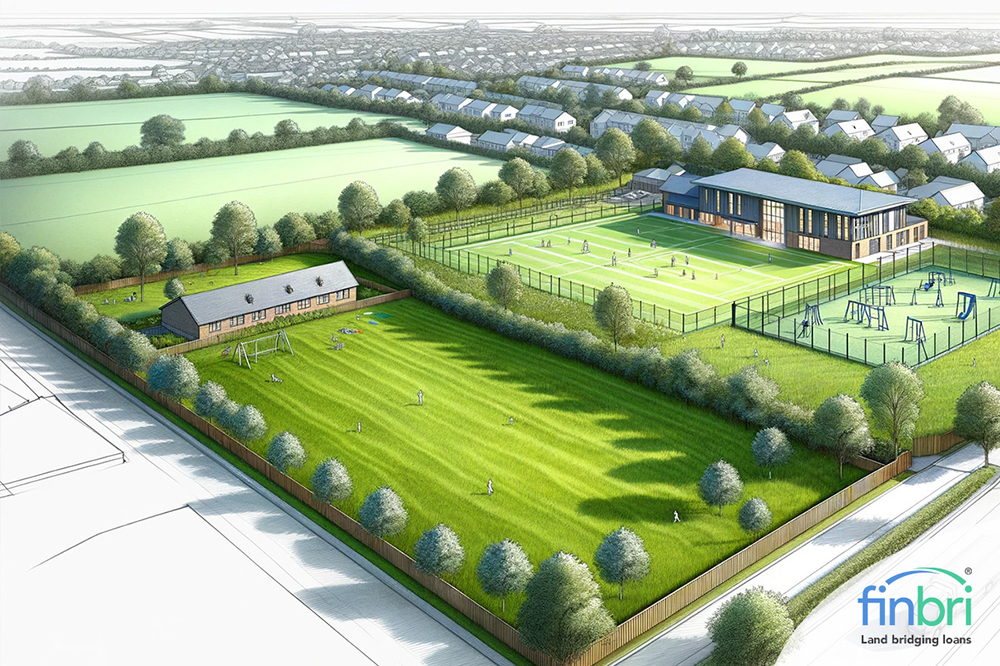
Who Uses Land Bridging Loans?
Both individuals and companies use land bridging finance. These include:
Property developers: Developers often use bridging finance to secure land quickly and start construction while arranging long-term financing or waiting to sell completed units.
Investors: Investors may use bridging finance to purchase land or property for investment purposes, such as buy-to-let properties or commercial real estate.
Homebuyers: Homeowners looking to purchase land for a new home may use bridging finance to bridge the gap between selling their current property and purchasing land to develop that land via a self-build loan.
Companies & Businesses: Organisations seeking to purchase additional ground either adjacent to their existing premises or in a new location for diversification, business expansion, development, car parking, storage or simply for speculation.
Auction buyers: Buyers participating in property auctions often rely on bridging finance to secure properties quickly, as auctions typically require immediate payment.

Eligibility for Land Bridging Finance
The typical eligibility criteria for obtaining land bridging finance include:
Borrower's creditworthiness: While credit history is considered, lenders prioritise the value and potential of the land or property used as collateral.
Exit strategy: A clear and feasible loan repayment plan is essential. The lender will assess the viability of the exit strategy, such as the sale of the land or property or refinancing with long-term financing.
Property valuation: The value of the purchased land or property is evaluated to determine the loan amount and loan-to-value ratio.
Appropriate security: The land or property used as collateral should have sufficient value and be marketable to mitigate the lender's risk.
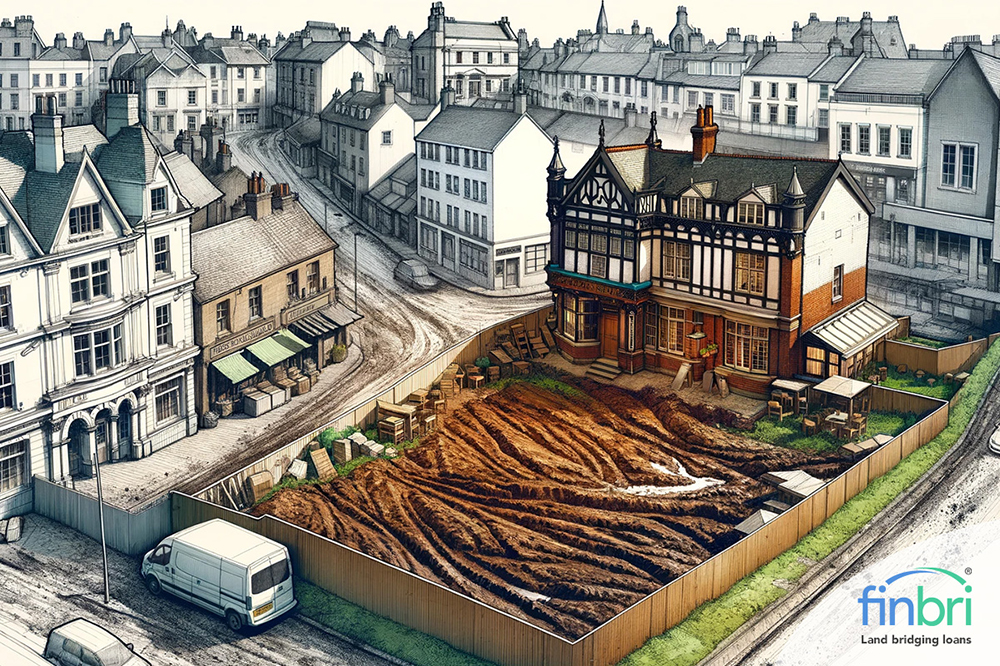
How long does it take to get a Land Bridging Loan?
It takes between 72 hours (3 days) and four weeks to obtain land bridging finance up to £10m. For larger loans, it can take up to 3 months. The speed of loan completion is affected by factors such as the complexity of the transaction, the borrower's preparedness, and the lender's process.

Information required for a Land Loan application
Land bridging loan lenders will typically require four key pieces of information for a loan application:
- Details of the purchased land or property, including location, size, and existing planning permissions.
- Personal or company financial information, including income, assets, and liabilities.
- A well-defined plan outlines how the loan will be repaid, such as through selling the land or property or refinancing.
- Relevant documents include land or property valuation reports, identification documents, and legal paperwork.
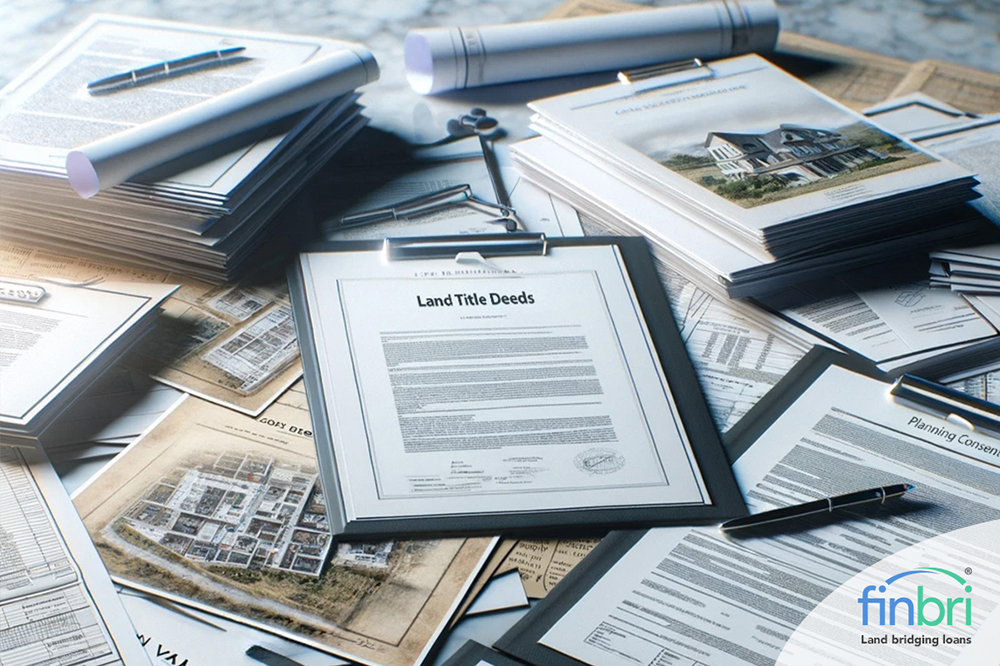
What's the difference between Land with Planning and Land without Planning?
Land with planning refers to land that already has obtained planning permission for specific uses, such as residential, commercial, or industrial development.
This type of land often carries higher value and is more attractive to lenders and developers due to reduced uncertainty. On the other hand, land without planning permission does not have pre-approved development rights. However, it can still be eligible for bridging finance, provided the borrower has a viable plan for obtaining the necessary permissions.

Types of Land purchased in the UK
Bridging finance can be used to acquire various sites and types of land in the UK, including:
Residential land: Land intended to develop residential properties, such as houses, apartments, or housing estates.
Commercial land: Land designated for commercial use, such as offices, retail spaces, industrial sites, or warehouses.
Agricultural land: Land primarily used for agricultural purposes, such as farming, livestock rearing, or horticulture.
Development land: Land suitable for development, which may require planning permission for residential, commercial, or mixed-use projects.

Different types of Land in the UK and their uses
Greenfield land: Undeveloped land, typically outside urban areas, often used for agricultural purposes or potential development.
Brownfield land: Previously developed land, often in urban areas, which may require remediation before redevelopment. Even where there is no possibility of development on a specific brownfield site, the land may still be valuable to developers due to the recent environmental requirements imposed by the UK government.
Agricultural land: Land used for farming, crop cultivation, or livestock rearing.
Residential land: Land designated for residential purposes, suitable for building houses, apartments, or housing estates.
Commercial land: Land intended for commercial use, such as offices, retail spaces, or industrial sites.
Mixed-use land: Land suitable for a combination of residential and commercial development, typically incorporating both residential and commercial properties in a single project.
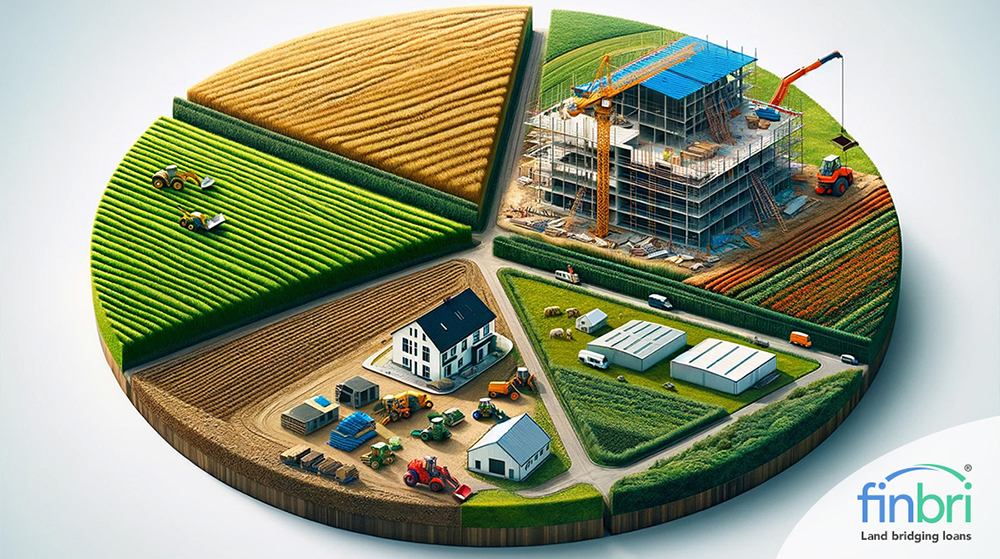
What are the five most valuable types of Land in the UK?
The five most valued land types in the UK are:
- Land with existing planning permission for desirable uses such as residential or commercial development.
- Well-located land with good transportation links and access to amenities.
- Land in areas experiencing high demand for housing or commercial development.
- Land in regions with strong economic growth and investment potential.
What impacts land value?
Location, existing infrastructure, planning permissions, and market demand all influence the value and risk profile of land, which alters the maximum loan amount you'll be able to raise.
What is "Hope Value" for Land speculation?
"Hope Value" refers to the potential increase in land value due to the expectation of obtaining planning permission in the future.
It represents the added value attributed to the land based on the anticipation of favourable planning decisions. Speculators may purchase land to secure planning permission, which can significantly increase the land's value.
However, it is important to note that obtaining planning permission is not guaranteed, and factors such as local planning policies and regulations can affect the outcome.
We're financial experts who arrange land bridging loans for developers, investors and farmers, securing you the best land finance deals from UK specialist lenders, including private equity firms, private investors and family offices.
Get expert assistance today, we're on hand to answer any questions about bridging loans.
Call our friendly team on 01202 612934, we're ready to help.
Bridging Loan Case Studies
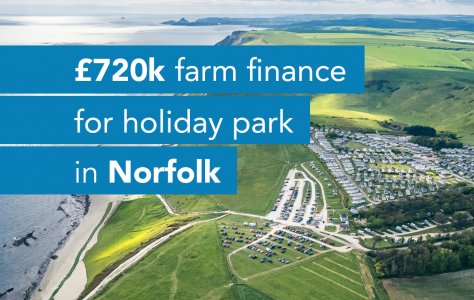
Farm development finance of £720,000 for holiday park diversification in Norfolk
Finance: £720,000Location: Norfolk

Garden plot opportunity with bridging finance in Gloucester
Finance: £400,000Location: Gloucester
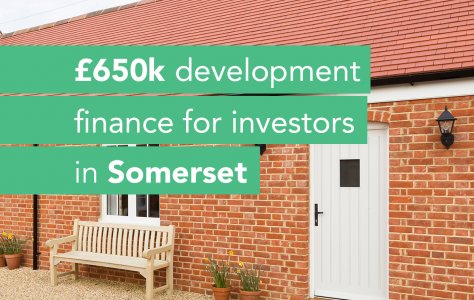
Development finance secures land for 9 holiday homes
Finance: £650,000Location: Somerset
Whats the longest term bridge finance that you can get for land?
Land bridging loans are only intended to be a short term solution and are typically on available for up to 36 months. If you require longer term finance then you should seek advice for a land mortgage.
What's the maximum LTV on land bridging loans?
Lenders normally offer less loan to value (LTV) ratios on land loan compared with property. You can expect to be offered 60-70% of the gross land value if planning permission is granted and subject to the type of land it is. If you don't have planning approval this could go lower than 50% LTV. For a land bridge deal you will require a deposit of at least 35% due to the interest and fees reducing the LTV by up to 5%.
Land bridge loan eligibility
There are factors that lenders use in deciding what rates to offer. Borrowers with this type of credit usually get the best deal. Lenders also take into account factors including the cost of a bridge loan.
Exit strategies for land bridge loans
An exit strategy is the way you plan to terminate a loan at their final settlement day. In the context of bridging loan, an exit strategy is applied to map the way you will repay debt. There are multiple methods for exiting a land bridge loan such as:
- Sale of the land once planning permission has been obtained
- Developing the land and refinancing the bridge with development finance
- Refinance the land bridge loan with another bridge loan
- Refinance the loan with a longer term finance solution such as a land mortgage
Can I get a bridging loan for land?
Yes, bridging loans are commonly used for funding the purchase of land with or without planning. A land bridge loan is a short-term loan secured against a piece of land, which typically doesn't have any buildings/structures standing on it.
Can you get Land Finance?
Yes, you can get land finance if you own or intend to acquire land that can be developed, or land that might be suitable for future development. You will need a plan from your architect and a financial model showing how the property will make money after it is built, as well as an estimate of how much funding you'll need to complete the project.
Do I need planning to raise financing via a land bridge loan?
No you don't need planning to raise finance via a land bridge loan. You can obtain a land bridge loan for land with or without planning. Bear in mind that the maximum LTV (Loan to value) is less for land without planning (up to 70% LTV for land with planning or up to 50% for land without planning permission). It's also possible to raise 100% of the finance you require if you're able to provide additional security.
Land bridge finance is frequently used for land purchases that need to be secured immediately, but where the land owner does not yet have planning permission or may simply not want to wait until they get it. This is known as land purchase with bare land planning consent.
How do you qualify for land bridging finance?
The land owner must have enough equity in the land to cover what is being borrowed from the lender and also that they are able to pay back a loan of this kind on time without defaulting.
Can I get loan to purchase a land?
A land bridging loan can be used to purchase land where the owner doesn't have planning permission or has no immediate intention of applying for it. Bridging loans are also often used in cases where a property is being purchased before its development value is realised, as they provide quick access to funds without long application processes or extensive paperwork. Aside from buying land it can also be used to refinance land.
Is it hard to get financing for purchasing land?
No, providing you secure the loan against an asset, typically the land itself or property, obtaining a bridging loan is straight forward and quick.
What types of land purchases can a bridging loan be used for?
Land bridging loan be used to purchase:
- Agricultural land
- Commercial land
- Residential land
- Industrial land
- Brownfield land
- Green land
Please note the types of land listed above are not exhaustive, contact us if you wish to purchase land not listed here.
Bridging finance for Agricultural land
Agricultural land also known as farmland or cropland is land typically used for pasture, livestock or the production of crops. It can also be used for limited equestrian activities however there are specific rules governing land use so if you're unsure then consult your local planning advisory service.
Section 336 of the Town and Country Planning Act 1990 defines ‘Agriculture’ as: “horticulture, fruit growing, seed growing, dairy farming, the breeding and keeping of livestock (including any creature kept for the production of food, wool, skins or fur, or for the purpose of its use in the farming of land), the use of land as grazing land, meadow land, osier land, market gardens and nursery grounds, and the use of land for woodlands where that use is ancillary to the farming of land for other agricultural purposes”.
Bridging finance for Commercial land
Commercial land means land which is used for commercial purposes such as office buildings or space, industrial sites and retail.
Bridging finance for Residential land
Residential land means land that is currently being used as a dwelling or is suitable for being used as, or is to be developed for dwellings.
Bridging finance for Industrial land
Industrial land means land which is utilised in connection with manufacturing, processing, or raw materials storage at facilities identified.
Bridging finance for Brownfield land
In urban planning, brownfield land is any land that has been previously developed but not currently in use that could potentially be contaminated.
What types of development can I finance using a bridging loan?
Land bridge finance are frequently used for land purchases that need to be secured immediately, but the land owner does not yet have planning permission or may simply not want to wait until they get it. This is known as land purchase with bare land planning consent.
This is different to development financing, if you're considering developing the land then view our development finance page.
